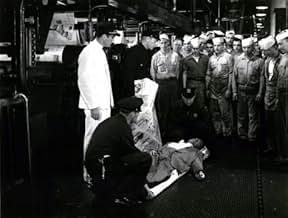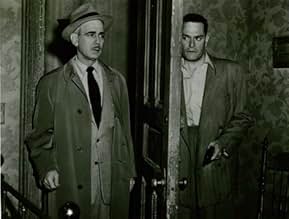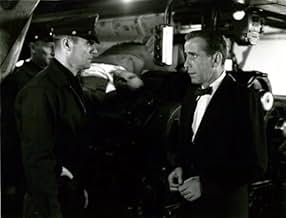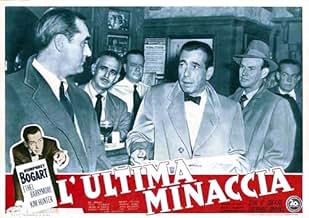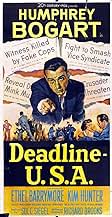VALUTAZIONE IMDb
7,2/10
4643
LA TUA VALUTAZIONE
Il direttore del quotidiano Day sa che la libertà di stampa è messa in pericolo ogni volta che una testata giornalistica giustamente critica rischia di venir assorbita da un gruppo editorial... Leggi tuttoIl direttore del quotidiano Day sa che la libertà di stampa è messa in pericolo ogni volta che una testata giornalistica giustamente critica rischia di venir assorbita da un gruppo editoriale con meno scrupoli.Il direttore del quotidiano Day sa che la libertà di stampa è messa in pericolo ogni volta che una testata giornalistica giustamente critica rischia di venir assorbita da un gruppo editoriale con meno scrupoli.
- Regia
- Sceneggiatura
- Star
- Premi
- 2 vittorie totali
Joe De Santis
- Herman Schmidt
- (as Joseph De Santis)
Parley Baer
- Headwaiter
- (non citato nei titoli originali)
Bill Baldwin
- Man Asking for Ed Hutcheson
- (non citato nei titoli originali)
Willis Bouchey
- Henry
- (non citato nei titoli originali)
Lovyss Bradley
- Woman
- (non citato nei titoli originali)
John Brooks
- Reporter
- (non citato nei titoli originali)
Ralph Brooks
- Newspaperman
- (non citato nei titoli originali)
Recensioni in evidenza
Better than average newspaper drama from the Fifties. Seems to be a more or less forgotten Humphrey Bogart film, which is too bad. I couldn't find it on DVD anywhere, and watched it on a tape I made from cable ten or more years ago. The film has three intertwining plot arcs done very skillfully by screenwriter (and director) Richard Brooks. Martin Gabel plays the bad guy, a mobster who is suitably menacing, without overdoing it. Icon Ethel Barrymore puts in a fine turn as the newspaper heiress, and the lovely Kim Hunter shines as Bogey's ex-wife. Bogart is outstanding as the crusading newspaper editor, doing everything possible to save his paper, and bringing low the criminal element. Definitely worth seeing, if you can find it.
"It's not our job to prove he's guilty. We're not detectives and we're not in the crusading business." That line from Humphrey Bogart early in the film lets you know you're watching a movie about a bygone era in journalism. Or maybe that's just an idealized fantasy and reporters were never like that, because later in the film Bogart contradicts himself by instructing his reporters to "go below the belt" and "we're gonna convict him of every crime on the books." Feelings on journalistic philosophy aside, this is an exceptional crime drama about the goings-on at a newspaper that's going out of business. Before the doors are closed, editor Bogart and his reporters try to uncover the truth about a racketeer's criminal activities.
Bogart turns in one of his finest acting turns, with terrific support from Ethel Barrymore, Martin Gabel, Ed Begley, Kim Hunter, Warren Stevens, Jim Backus, and many more. The story moves along at a smooth pace and keeps your interest throughout. There's quite a bit of monologuing but the script is packed with punch and grit. It's one of the better films in writer & director Richard Brook's career. It's worth a look on its merits as a dramatic film, as well as the added historic value it has for those looking to examine the differences and similarities between how journalism was viewed yesterday versus today.
Bogart turns in one of his finest acting turns, with terrific support from Ethel Barrymore, Martin Gabel, Ed Begley, Kim Hunter, Warren Stevens, Jim Backus, and many more. The story moves along at a smooth pace and keeps your interest throughout. There's quite a bit of monologuing but the script is packed with punch and grit. It's one of the better films in writer & director Richard Brook's career. It's worth a look on its merits as a dramatic film, as well as the added historic value it has for those looking to examine the differences and similarities between how journalism was viewed yesterday versus today.
Deadline - U.S.A. has Humphrey Bogart as the editor of a big city newspaper that is in the process of being sold to a Rupert Murdoch like chain that publishes scandal sheets. His paper is in the process at the same time of doing an expose of notorious racketeer Martin Gabel.
And if that ain't enough for Bogey his wife Kim Hunter is splitting from him. It's the usual story, she can't stand having him married to her and the paper as well.
Growing up in New York in the Fifties we had several newspapers, each vying for a smaller readership. I remember we had the Times, News, Post, Herald Tribune, World-Telegram&Sun, Journal-American, and the Daily Mirror. Some of those you can see are the products of consolidation, there were more in the past. After a printer's strike in the sixties most of them went out of business.
The papers were competing for a shrinking share of readership. In the previous generation, radio competed with the print media and I grew up with that new phenomenon of television. Today we are seeing the effects of the Internet as the individual's primary source for news.
The gangster part of the plot gets started with the discovery of the body of a Virginia Hill like moll, the former mistress of Martin Gabel. While some of the scandal sheets cover the sensational aspects of the murder of a glamor girl, Bogey's paper does some serious investigative reporting and uncovers a lot of evidence. Their work also has consequences including the maiming of young reporter Warren Stevens.
In the meantime the heirs of the newspaper's original founder are looking to sell the paper. Opposing it is their mother, Ethel Barrymore and she has a fine part and is obviously the model for the widow publisher played by Nancy Marchand in Lou Grant. She has one classic scene with Humphrey Bogart where they commiserate over their mutual problems.
Deadline - U.S.A. is a realistic look at the life of a big city paper in days gone by. It's a gritty piece of nostalgia, as timely in its day as The Front Page was in the Twenties. Cast members like Paul Stewart, Jim Backus, and Ed Begley look and feel right at home at their jobs.
The film is recommended particularly for younger viewers who are glued to their computers and television to see how a newspaper functioned back in the day.
And if that ain't enough for Bogey his wife Kim Hunter is splitting from him. It's the usual story, she can't stand having him married to her and the paper as well.
Growing up in New York in the Fifties we had several newspapers, each vying for a smaller readership. I remember we had the Times, News, Post, Herald Tribune, World-Telegram&Sun, Journal-American, and the Daily Mirror. Some of those you can see are the products of consolidation, there were more in the past. After a printer's strike in the sixties most of them went out of business.
The papers were competing for a shrinking share of readership. In the previous generation, radio competed with the print media and I grew up with that new phenomenon of television. Today we are seeing the effects of the Internet as the individual's primary source for news.
The gangster part of the plot gets started with the discovery of the body of a Virginia Hill like moll, the former mistress of Martin Gabel. While some of the scandal sheets cover the sensational aspects of the murder of a glamor girl, Bogey's paper does some serious investigative reporting and uncovers a lot of evidence. Their work also has consequences including the maiming of young reporter Warren Stevens.
In the meantime the heirs of the newspaper's original founder are looking to sell the paper. Opposing it is their mother, Ethel Barrymore and she has a fine part and is obviously the model for the widow publisher played by Nancy Marchand in Lou Grant. She has one classic scene with Humphrey Bogart where they commiserate over their mutual problems.
Deadline - U.S.A. is a realistic look at the life of a big city paper in days gone by. It's a gritty piece of nostalgia, as timely in its day as The Front Page was in the Twenties. Cast members like Paul Stewart, Jim Backus, and Ed Begley look and feel right at home at their jobs.
The film is recommended particularly for younger viewers who are glued to their computers and television to see how a newspaper functioned back in the day.
This wonderful 1952 film - it must have been approaching Humphrey's last performance - wins on all levels.
It triumphs as an historical curiosity into how newspapers were published 50 years ago, down to the presses and the layouts and assignments, and also for its truly remarkable supporting cast, many of them, some famous, like Ethel Barrymore, Jim Backus and Ed Begley and some part of the Hollywood backdrops in score of movies.
Kim Hunter excels also as the Bogart ex. Martin Gabel eerily predicts the Tony Soprano performance of today as an underworld Kingpin shown with his perfect domestic arrangement.
The scene of the "wake" for the death of the newspaper is wonderful, and also some wonderful camera pans on continuous action in many scenes.
The script is well done and keeps the action moving along, some funny throwaway lines too, particularly in the car scene with the mobster and in his ex-wife's bedroom.
Also it is subtle and understated and not rampant with the 2X4's of some of today's instant-soup scripts. Do not miss this one, Bogie and Kim fans!!
8 out of 10.
It triumphs as an historical curiosity into how newspapers were published 50 years ago, down to the presses and the layouts and assignments, and also for its truly remarkable supporting cast, many of them, some famous, like Ethel Barrymore, Jim Backus and Ed Begley and some part of the Hollywood backdrops in score of movies.
Kim Hunter excels also as the Bogart ex. Martin Gabel eerily predicts the Tony Soprano performance of today as an underworld Kingpin shown with his perfect domestic arrangement.
The scene of the "wake" for the death of the newspaper is wonderful, and also some wonderful camera pans on continuous action in many scenes.
The script is well done and keeps the action moving along, some funny throwaway lines too, particularly in the car scene with the mobster and in his ex-wife's bedroom.
Also it is subtle and understated and not rampant with the 2X4's of some of today's instant-soup scripts. Do not miss this one, Bogie and Kim fans!!
8 out of 10.
A very good movie about The Day, a newspaper publishing its last editions, and its aggressive attack on a known mobster.
Humphrey Bogart does an excellent job as the editor, and Ethel Barrymore gives a wonderful, regal performance as the widow of the publisher, whose daughters are now demanding that the paper be sold to a competitor.
The film brings up, a mere 53 years ago, issues that are relevant today - the tabloids versus real, factual news, and the meaning of a free press. These debates continue today, but unfortunately, it seems that the tabloid type of journalism is winning.
As for a free press - our press might be freer than many, but it isn't entirely free. As anyone who lost money in the great savings and loan scandal can tell you, important stories disappear from the front pages all the time.
Bogart's strong performance is the engine that keeps this film going, and there's a nice performance by Kim Hunter as his ex-wife.
Deadline USA reminds us of the good old days, when you could believe what you read in the New York Times.
Humphrey Bogart does an excellent job as the editor, and Ethel Barrymore gives a wonderful, regal performance as the widow of the publisher, whose daughters are now demanding that the paper be sold to a competitor.
The film brings up, a mere 53 years ago, issues that are relevant today - the tabloids versus real, factual news, and the meaning of a free press. These debates continue today, but unfortunately, it seems that the tabloid type of journalism is winning.
As for a free press - our press might be freer than many, but it isn't entirely free. As anyone who lost money in the great savings and loan scandal can tell you, important stories disappear from the front pages all the time.
Bogart's strong performance is the engine that keeps this film going, and there's a nice performance by Kim Hunter as his ex-wife.
Deadline USA reminds us of the good old days, when you could believe what you read in the New York Times.
Lo sapevi?
- QuizOriginally titled 'The Newspaper Story', location shooting took place both in the newsroom and the printing plant of The New York Daily News, with real pressmen playing themselves. This was augmented by an 'almost letter-perfect' reproduction of a newsroom on a Hollywood soundstage.
- BlooperAs Rienzi's car drives off after picking up Hutcheson, a large studio light is reflected against the side window of the car.
- Citazioni
[last lines]
Ed Hutcheson: That's the press, baby. The press! And there's nothing you can do about it. Nothing!
- ConnessioniFeatured in L'unico gioco in città (1970)
- Colonne sonoreJohn Brown's Body
(uncredited)
Traditional tune, lyrics attributed to various writers
Sung, with modified lyrics, by the staff in the bar and heard as a theme at other times.
I più visti
Accedi per valutare e creare un elenco di titoli salvati per ottenere consigli personalizzati
- How long is Deadline - U.S.A.?Powered by Alexa
Dettagli
Botteghino
- Lordo in tutto il mondo
- 5228 USD
- Tempo di esecuzione
- 1h 27min(87 min)
- Colore
- Proporzioni
- 1.37 : 1
Contribuisci a questa pagina
Suggerisci una modifica o aggiungi i contenuti mancanti


